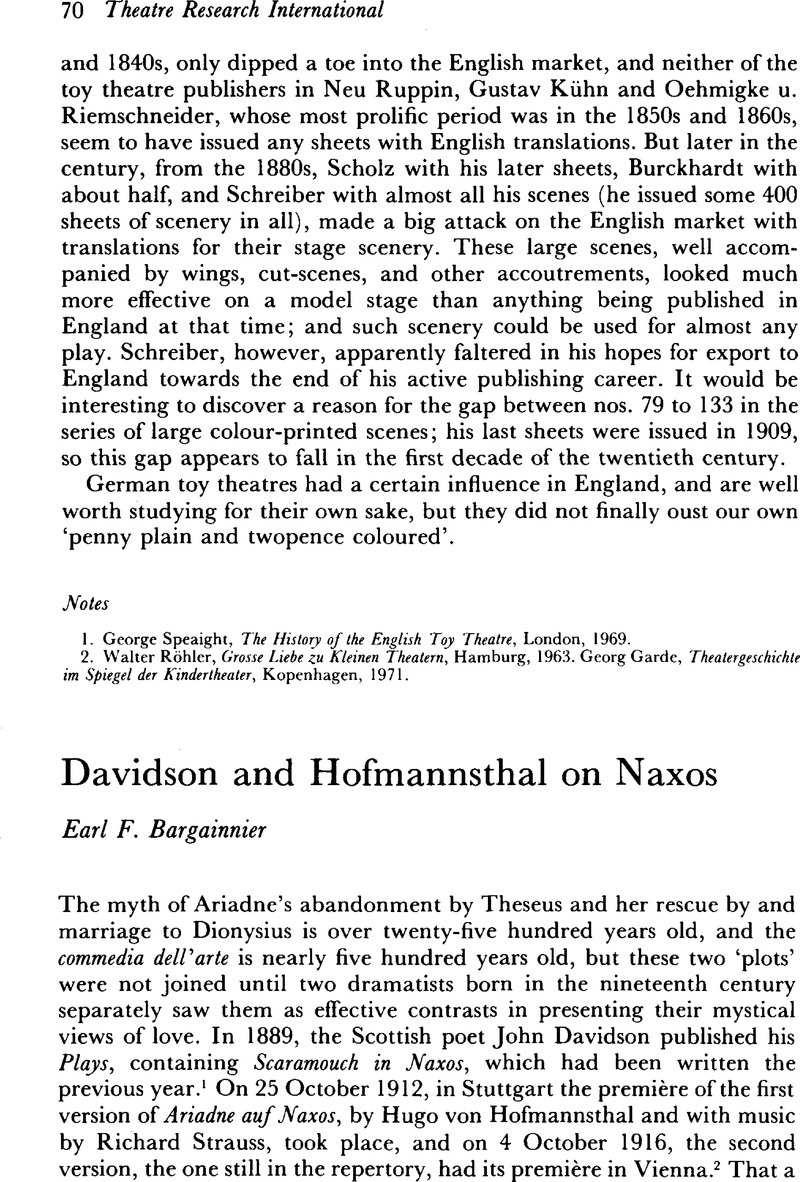Published online by Cambridge University Press: 23 January 2009

1. The first edition of Plays was privately printed in Greenock, Scotland, in 1889. It was reprinted by T. Fisher Unwin of London in 1890 as Scaramouch in Naxos: A Pantomime and Other Plays. This edition, through the courtesy of the Library of Congress, will be used for this study, and all quotations from it will be cited in the text. In 1894 another edition of Plays appeared, now containing five rather than the original three (London: Elkin Mathews and John Lane, and Chicago: Stone and Kimball); for this edition of five hundred copies, Davidson accepted twenty-five pounds as full payment of royalties (MacLeod, R. D., John Davidson: A Study in Personality, Glasgow, 1957, p. 13Google Scholar). Such low payment is an indication of Davidson's lack of commercial success as a dramatist. He wrote fourteen known plays, all but one of which were published, but only three – all adaptations – were produced.
2. All references to Ariadne auf Naxos are to the second version. The English translation used is that of Alfred Kalisch, published by Boosey and Hawkes and issued with the Angel recording of the opera (3532C); all quotations refer to this edition and will be included in the text. The German edition used in preparing the study is Gesammelte Werke (Berlin, 1924), I, 295–351.Google Scholar Two works indispensable for the study of Hofmannsthal's Ariadne are The Correspondence Between Richard Strauss and Hugo von Hofmannsthal, ed. Franz, and Strauss, Alice, trans. Hans Hammelmann and Ewald Osers, London, 1961Google Scholar, and Daviau, Donald G. and Buelow, George J., The Ariadne auf Naxos of Hugo von Hofmannsthal and Richard Strauss, University of North Carolina Studies in the Germanic Language and Literature, No. 80, Chapel Hill, 1975.Google Scholar Quotations from these works will be cited in the text, using the abbreviations C for the Correspondence and DB for Daviau and Buelow.
3. See Gilbert, Mary E., ‘Hugo von Hofmannsthal and England’, German Life and Letters, 1 (1936–1937), 182–93.Google Scholar Gilbert says that ‘Hofmannsthal's relations to English artistic and literary life in the ‘nineties were … considerable. They influenced his conception of the world; and in his poetic practice he sometimes followed English examples, and used English poetic forms’ (190). Gilbert does not give illustrations of such use, nor does she list Davidson among the numerous English writers who attracted Hofmannsthal.
4. For the background of the commedia dell'arte, I am indebted to Smith, Winifred, The Commedia dell'Arte, New York, 1912 (rpt. 1964)Google Scholar; Lea, K. M., Italian Popular Comedy, New York, 1934 (rpt. 1962), 2 vols.Google Scholar; Scenarios of the Commedia dell'Arte: Flaminio Scala's Il Teatro delle favole rappresentative, trans. Salerno, Henry F., New York and London, 1967Google Scholar; and Nicoll, Allardyce, The World of Harlequin, Cambridge, 1963.Google Scholar
5. Smith, Patrick J., The Tenth Muse: A Historical Study of the Opera Libretto, New York, 1970, p. 367.Google Scholar
6. In his ‘Hand-List of Plays’ in A History of English Drama: IV. Early Nineteenth Century Drama and V. Late Nineteenth Century Drama (Cambridge, 1960 and 1962)Google Scholar, Allardyce Nicoll includes nearly forty burlesque-extravaganzas on classical myths. Most appeared from 1850 to 1870, probably as a result of the success of James Robinson Planché's eleven classical extravaganzas. Only two are based upon the Ariadne myth: an unknown author's Theseus and Ariadne; or, The Labyrinth of Crete (1836) and Planché's Theseus and Ariadne (1848).
7. Fineman, Hayim, John Davidson: A Study of the Relation of His Ideas to His Poetry, Philadelphia, 1916 (rpt. 1969), p. 6.Google Scholar
8. See Plate 321 in Reade, Brian, Aubrey Beardsley, New York, 1967.Google Scholar Beardsley uses acquaintances as characters in his drawing, including his sister Mabel as Ariadne, the dancer Adeline Genée as Columbine, Oscar Wilde as Bacchus (in grape leaves and leopard skin), and Sir Augustus Harris, manager of Covent Garden and Drury Lane, as Scaramouch.
9. Peterson, Carroll V., John Davidson, New York, 1972, p. 34.Google Scholar
10. Turnbull, Andrew, ed., The Poems of John Davidson, Totowa, N. J., 1973, I, xvii.Google Scholar
11. Smith, p. 365.